The prefabricated composite sandwich panels market is set to experience substantial growth between 2025 and 2035, with a forecasted CAGR of 7.2%. The market is expected to increase from USD 6,797.3 million in 2025 to USD 13,623.3 million by 2035, indicating a strong upward trajectory. The demand for these panels is being driven by their inherent advantages, such as light weight, high strength, and cost-effective manufacturing processes.
These attributes make them an attractive choice for construction and industrial applications, where cost-efficiency and fast assembly are prioritized. The growth in sectors like commercial and residential construction, as well as transportation, will likely serve as major catalysts for the increasing adoption of prefabricated composite sandwich panels over the next decade.
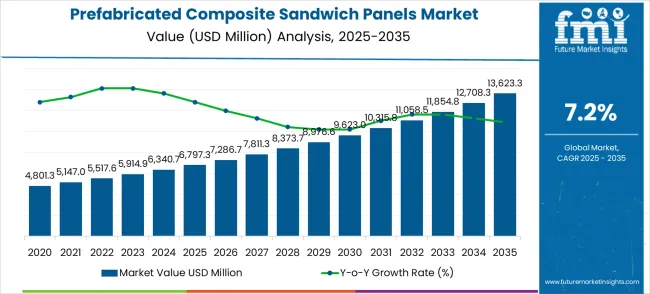
The ongoing emphasis on reducing construction timeframes while improving structural integrity is expected to propel the market further. As these panels offer faster installation times compared to traditional construction materials, their adoption is anticipated to increase significantly in both developed and emerging markets.
The continued growth of the market is also supported by the panels’ ability to meet stringent insulation and fire safety standards, which is becoming increasingly important in the construction industry. Given the expected acceleration in global construction activities, the prefabricated composite sandwich panels market will likely benefit from a combination of growing demand and increasing investments in infrastructure, positioning it for sustained growth throughout the forecast period.
The prefabricated composite sandwich panels market holds around 8% of the share within the building materials market, driven by the demand for lightweight and durable construction solutions. In the construction materials market, it captures approximately 10%, as sandwich panels are preferred for their efficiency in thermal insulation and structural strength. Within the prefabricated building components market, it accounts for about 12%, reflecting its significant role in modular construction.
The insulation materials market sees about 9%, as these panels offer excellent insulation properties, making them a cost-effective choice in construction. In the green building materials market, it holds approximately 7%, as energy-efficient solutions like composite sandwich panels are gaining traction in sustainable construction. These figures illustrate the growing preference for prefabricated composite sandwich panels across various sectors, driven by their performance, cost-efficiency, and environmental benefits.
| Metric | Value |
|---|---|
| Market Value (2025) | USD 6,797.3 million |
| Market Forecast Value (2035) | USD 13,623.3 million |
| Forecast CAGR (2025 to 2035) | 7.2% |
Market expansion is being supported by the rapid advancement of construction industrialization across developing economies and the corresponding need for efficient and lightweight building solutions for modern construction projects in urban environments. Modern construction operations require superior structural performance and thermal efficiency to ensure optimal building performance and energy conservation. The exceptional strength-to-weight ratio and insulation characteristics of prefabricated composite sandwich panels make them essential components in demanding construction environments where performance efficiency is critical.
The growing emphasis on sustainable construction and building performance is driving demand for advanced sandwich panel technologies from certified manufacturers with proven track records of quality and environmental compliance. Construction operators are increasingly investing in prefabricated systems that offer enhanced thermal performance and reduced construction timelines over traditional building methods. Building codes and energy efficiency standards are establishing performance benchmarks that favor engineered sandwich panel solutions with advanced structural and thermal capabilities.
The market is segmented by panel type, application, and region. By panel type, the market is divided into foam sandwich panels, honeycomb sandwich panels, aluminum alloy sandwich panels, stainless steel sandwich panels, and other configurations. Based on application, the market is categorized into construction, transportation, industrial manufacturing, consumer electronics, and other applications. Regionally, the market is divided into North America, Europe, East Asia, South Asia & Pacific, Latin America, and Middle East & Africa.
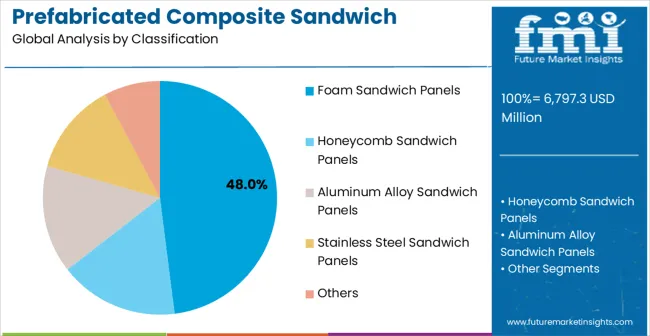
Foam sandwich panels are projected to account for 48% of the prefabricated composite sandwich panels market in 2025. This leading share is supported by the increasing demand for cost-effective insulation solutions in construction applications and growing requirements for thermal efficiency in building envelope systems. Foam sandwich panels provide excellent thermal insulation and structural performance, making them the preferred choice for residential construction, commercial buildings, and industrial facility applications. The segment benefits from technological advancements that have improved the fire resistance and structural integrity of foam core panels while maintaining cost-effectiveness and installation efficiency.
Modern foam sandwich panels incorporate advanced polymer foam cores, high-strength facings, and sophisticated adhesive systems that enhance thermal performance and extend service life. These innovations have significantly improved building energy efficiency while reducing total cost of ownership through enhanced durability and elimination of thermal bridging issues. The residential and commercial construction sectors particularly drive demand for foam sandwich panel solutions, as these industries require superior insulation performance to maintain energy compliance and meet stringent building standards.
Additionally, the prefabricated construction industry increasingly adopts foam sandwich panels to reduce construction time and meet sustainable building certifications. Energy efficiency requirements and green building initiatives further accelerate market adoption, as foam panels provide enhanced thermal performance while supporting rapid construction assembly and environmental compliance.
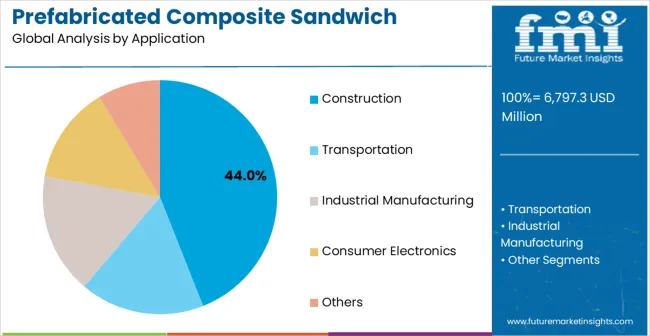
Construction applications are expected to represent 44% of prefabricated composite sandwich panels demand in 2025. This substantial share reflects the critical role of sandwich panels in modern construction methods and the need for efficient building solutions capable of meeting diverse architectural and performance requirements in contemporary building projects. Construction projects require effective and durable panel systems for structural support, thermal insulation, and aesthetic versatility. The segment benefits from ongoing urbanization in developing countries and increasing adoption of prefabricated construction methods in residential, commercial, and industrial building projects.
Construction applications demand exceptional structural performance and thermal efficiency to ensure building code compliance and occupant comfort. These applications require panels capable of handling various loads, environmental conditions, and architectural design requirements while maintaining long-term performance reliability. The growing emphasis on construction speed and energy efficiency, particularly in residential and commercial building markets, drives consistent demand for high-performance sandwich panel solutions. Emerging construction markets in Asia-Pacific, Latin America, and Middle East regions contribute significantly to market growth as developers invest in modern building technologies to improve construction efficiency and building performance.
Additionally, the trend toward sustainable construction and net-zero buildings creates opportunities for specialized sandwich panel systems equipped with enhanced thermal properties and integrated renewable energy features. The segment also benefits from increasing infrastructure development and urban renewal projects driven by growing population density and infrastructure modernization requirements.
The prefabricated composite sandwich panels market is advancing rapidly due to increasing construction industrialization and growing recognition of building efficiency technology importance. However, the market faces challenges including raw material cost fluctuations, need for specialized installation expertise, and varying building code requirements across different regions. Standardization efforts and certification programs continue to influence panel quality and market development patterns.
The growing adoption of integrated sensor systems and digital monitoring capabilities is enabling real-time building performance assessment and predictive maintenance capabilities in sandwich panel installations. Smart building technologies and automated climate control systems provide continuous performance optimization while enhancing energy efficiency and extending building service life. These technologies are particularly valuable for large commercial and industrial buildings that require intelligent building management and comprehensive performance analytics.
Modern sandwich panel manufacturers are incorporating recycled materials and bio-based foam cores that improve environmental sustainability while maintaining structural performance through advanced material formulations and manufacturing processes. Integration of phase-change materials and advanced insulation technologies enables superior thermal performance and significant energy savings compared to traditional construction materials. Advanced manufacturing techniques and quality control systems also support development of more consistent and reliable sandwich panel products for demanding construction environments.
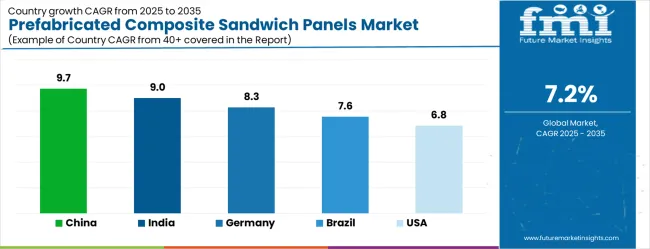
| Country | CAGR (2025-2035) |
|---|---|
| China | 9.7% |
| India | 9.0% |
| Germany | 8.3% |
| Brazil | 7.6% |
| United States | 6.8% |
| United Kingdom | 6.1% |
| Japan | 5.4% |
The prefabricated composite sandwich panels market is growing rapidly, with China leading at a 9.7% CAGR through 2035, driven by massive construction sector expansion, urbanization acceleration, and prefabricated construction adoption. India follows at 9.0%, supported by rising infrastructure investments and increasing adoption of modern construction technologies in residential and commercial development projects. Germany records strong growth at 8.3%, emphasizing precision engineering, sustainable construction, and advanced building technology capabilities.
Brazil grows steadily at 7.6%, integrating sandwich panel systems into expanding construction infrastructure and housing development programs. The United States shows moderate growth at 6.8%, focusing on building technology innovation and construction modernization improvements. The United Kingdom maintains steady expansion at 6.1%, supported by sustainable construction programs. Japan demonstrates stable growth at 5.4%, emphasizing technological innovation and construction excellence.
The report covers an in-depth analysis of 40+ countries, the top-performing countries are highlighted below.
The prefabricated composite sandwich panels market in China is projected to exhibit the highest growth rate with a CAGR of 9.7% through 2035, driven by rapid construction sector expansion and massive urbanization acceleration programs across metropolitan and developing regions.
The country's growing residential and commercial construction industries are creating significant demand for efficient building systems. Major construction companies are establishing comprehensive prefabricated building installations to support large-scale urban development operations and meet national construction modernization standards.
China's construction sector continues expanding rapidly, with major investments in residential housing, commercial complexes, and industrial facilities. The country's position as a global construction market leader drives substantial demand for innovative building solutions that ensure construction efficiency and structural performance across diverse building applications.
The prefabricated composite sandwich panels market in India is expanding at a CAGR of 9.0%, supported by increasing infrastructure investments across construction sectors and growing adoption of modern construction technologies in residential and commercial development projects. The country's expanding urban development programs are driving demand for efficient building systems capable of supporting rapid construction requirements. Construction companies are investing in sandwich panel technologies to improve building efficiency and comply with modern construction standards.
India's infrastructure development initiatives and construction modernization create significant opportunities for sandwich panel applications. The country's growing construction market drives demand for residential housing and commercial development, requiring efficient building solutions to maintain construction schedules and quality standards.
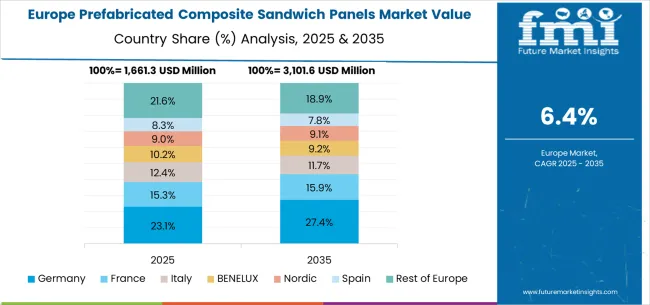
The prefabricated composite sandwich panels market in Germany is projected to grow at a CAGR of 8.3%, supported by the country's emphasis on sustainable construction excellence and advanced building technology capabilities. German construction facilities are implementing high-performance sandwich panel systems that meet stringent environmental standards and building efficiency requirements. The market is characterized by focus on technological innovation, sustainable materials, and compliance with comprehensive building regulations.
Germany's advanced construction sector and sustainable building excellence capabilities drive demand for high-quality sandwich panel solutions. The country's emphasis on energy efficiency, technological innovation, and environmental sustainability creates opportunities for advanced building technologies that meet demanding performance specifications.
The prefabricated composite sandwich panels market in Brazil is growing at a CAGR of 7.6%, driven by expanding construction infrastructure and increasing housing development program implementation across urban and developing regions. The country's growing construction industry is investing in modern building systems to improve construction efficiency and building quality in competitive market conditions. Construction facilities are adopting sandwich panel technologies to support growing housing requirements and infrastructure development needs.
Brazil's expanding construction infrastructure and urban development create substantial opportunities for sandwich panel applications. The country's growing housing market and infrastructure expansion drive investments in building solutions that enhance construction competitiveness and development efficiency.
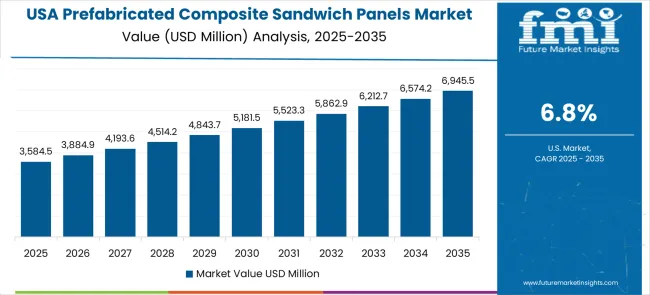
The prefabricated composite sandwich panels market in the United States is expanding at a CAGR of 6.8%, driven by ongoing building technology innovation and increasing emphasis on construction modernization solutions. Construction facilities are upgrading existing building methods with advanced technologies that provide improved performance and enhanced construction efficiency. The market benefits from building technology adoption and construction modernization programs across multiple building sectors.
The United States market emphasizes building innovation, construction technology advancement, and sustainable building improvement in sandwich panel applications. Advanced building technology development activities drive the adoption of next-generation panel systems that offer superior performance and construction efficiency capabilities.
The prefabricated composite sandwich panels market in the United Kingdom is projected to grow at a CAGR of 6.1%, supported by ongoing sustainable construction programs and building facility upgrades. Construction operators are investing in efficient sandwich panel systems that provide consistent performance and meet environmental compliance requirements. The market is characterized by focus on building efficiency, environmental sustainability, and construction compliance across diverse building applications.
The United Kingdom's focus on sustainable construction and building performance drives demand for high-efficiency sandwich panel solutions. The country's emphasis on energy efficiency, environmental compliance, and construction innovation creates opportunities for advanced building technologies.
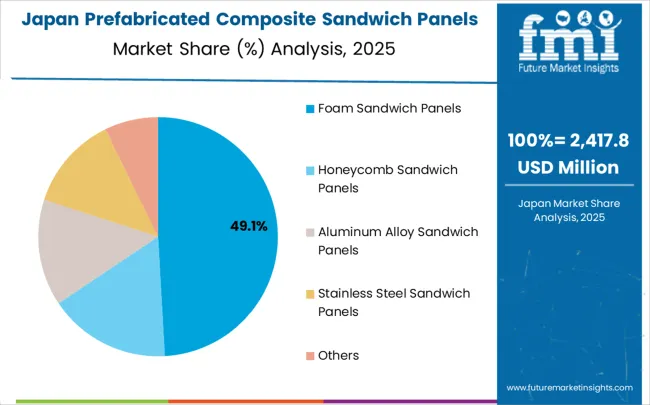
The prefabricated composite sandwich panels market in Japan is expanding at a CAGR of 5.4%, driven by the country's emphasis on technological innovation and construction excellence in building applications. Japanese manufacturers are developing advanced sandwich panel technologies that incorporate precision engineering and efficiency-optimized design principles. The market benefits from focus on quality, reliability, and continuous improvement in building technology performance.
Japan's technological leadership and construction expertise drive the development of advanced sandwich panel solutions. The country's emphasis on innovation, quality control, and building optimization creates opportunities for cutting-edge panel technologies that set construction industry standards.
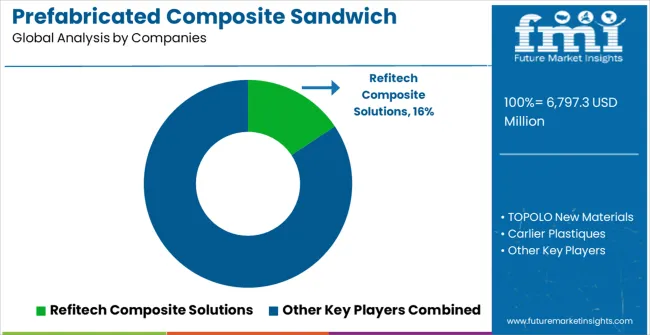
The prefabricated composite sandwich panels market is defined by competition among established construction materials manufacturers, specialized composite panel companies, and emerging sustainable building solution providers. Companies are investing in advanced materials technologies, manufacturing innovation, standardized quality systems, and technical support capabilities to deliver efficient, durable, and cost-effective sandwich panel solutions. Strategic partnerships, technological advancement, and geographic expansion are central to strengthening product portfolios and market presence.
Refitech Composite Solutions, operating globally, offers comprehensive sandwich panel solutions with focus on advanced composites, reliability, and technical support services. TOPOLO New Materials, multinational manufacturer, provides innovative panel systems with emphasis on material performance and construction integration capabilities. Carlier Plastiques, specialized provider, delivers advanced sandwich panel solutions for construction applications with focus on quality and performance. ACP Composites offers comprehensive panel technologies with standardized procedures and construction service support.
CoreLite Composites provides advanced sandwich panel systems with emphasis on lightweight applications and technical expertise. Hexcel Corporation, RhinoKore deliver specialized composite solutions with focus on high-performance construction applications. 3A Composites, Relinea offer comprehensive sandwich panel technologies for demanding building environments with established manufacturing and service capabilities.
Zhongjie Group, Marcegaglia, Ruukki, SCHÜTZ COMPOSITES, Sunnyda, Italpannelli, Silex provide advanced sandwich panel systems with regional manufacturing capabilities, construction industry expertise, and specialized knowledge across building technology and construction material sectors.
The prefabricated composite sandwich panels market underpins construction efficiency excellence, sustainable building advancement, structural performance optimization, and modern construction methodology implementation. With building code mandates, stricter energy efficiency requirements, and demand for rapid construction solutions, the sector must balance cost competitiveness, structural reliability, and environmental sustainability. Coordinated contributions from governments, industry bodies, OEMs/technology integrators, suppliers, and investors will accelerate the transition toward performance-optimized, environmentally sustainable, and technologically advanced sandwich panel systems.
| Item | Value |
|---|---|
| Quantitative Units | USD 6,797.3 million |
| Panel Type | Foam Sandwich Panels, Honeycomb Sandwich Panels, Aluminum Alloy Sandwich Panels, Stainless Steel Sandwich Panels, Others |
| Application | Construction, Transportation, Industrial Manufacturing, Consumer Electronics, Others |
| Regions Covered | North America, Europe, East Asia, South Asia & Pacific, Latin America, Middle East & Africa |
| Country Covered | United States, Germany, India, China, United Kingdom, Japan, Brazil, and other 40+ countries |
| Key Companies Profiled | Refitech Composite Solutions, TOPOLO New Materials, Carlier Plastiques, ACP Composites, CoreLite Composites, Hexcel Corporation, RhinoKore, 3A Composites, Relinea, Zhongjie Group, Marcegaglia, Ruukki, SCHÜTZ COMPOSITES, Sunnyda, Italpannelli, Silex |
| Additional Attributes | Dollar sales by panel type and application segments, regional demand trends across North America, Europe, and Asia-Pacific, competitive landscape with established manufacturers and emerging suppliers, buyer preferences for high-performance versus cost-effective panel systems, integration with sustainable construction and smart building technologies, innovations in materials science and manufacturing processes for enhanced structural performance and environmental sustainability, and adoption of prefabricated construction solutions with embedded energy efficiency and rapid assembly capabilities for improved construction efficiency. |
The global prefabricated composite sandwich panels market is estimated to be valued at USD 6,797.3 million in 2025.
The market size for the prefabricated composite sandwich panels market is projected to reach USD 13,623.3 million by 2035.
The prefabricated composite sandwich panels market is expected to grow at a 7.2% CAGR between 2025 and 2035.
The key product types in prefabricated composite sandwich panels market are foam sandwich panels, honeycomb sandwich panels, aluminum alloy sandwich panels, stainless steel sandwich panels and others.
In terms of application, construction segment to command 44.0% share in the prefabricated composite sandwich panels market in 2025.






Our Research Products

The "Full Research Suite" delivers actionable market intel, deep dives on markets or technologies, so clients act faster, cut risk, and unlock growth.

The Leaderboard benchmarks and ranks top vendors, classifying them as Established Leaders, Leading Challengers, or Disruptors & Challengers.

Locates where complements amplify value and substitutes erode it, forecasting net impact by horizon

We deliver granular, decision-grade intel: market sizing, 5-year forecasts, pricing, adoption, usage, revenue, and operational KPIs—plus competitor tracking, regulation, and value chains—across 60 countries broadly.

Spot the shifts before they hit your P&L. We track inflection points, adoption curves, pricing moves, and ecosystem plays to show where demand is heading, why it is changing, and what to do next across high-growth markets and disruptive tech

Real-time reads of user behavior. We track shifting priorities, perceptions of today’s and next-gen services, and provider experience, then pace how fast tech moves from trial to adoption, blending buyer, consumer, and channel inputs with social signals (#WhySwitch, #UX).

Partner with our analyst team to build a custom report designed around your business priorities. From analysing market trends to assessing competitors or crafting bespoke datasets, we tailor insights to your needs.
Supplier Intelligence
Discovery & Profiling
Capacity & Footprint
Performance & Risk
Compliance & Governance
Commercial Readiness
Who Supplies Whom
Scorecards & Shortlists
Playbooks & Docs
Category Intelligence
Definition & Scope
Demand & Use Cases
Cost Drivers
Market Structure
Supply Chain Map
Trade & Policy
Operating Norms
Deliverables
Buyer Intelligence
Account Basics
Spend & Scope
Procurement Model
Vendor Requirements
Terms & Policies
Entry Strategy
Pain Points & Triggers
Outputs
Pricing Analysis
Benchmarks
Trends
Should-Cost
Indexation
Landed Cost
Commercial Terms
Deliverables
Brand Analysis
Positioning & Value Prop
Share & Presence
Customer Evidence
Go-to-Market
Digital & Reputation
Compliance & Trust
KPIs & Gaps
Outputs
Full Research Suite comprises of:
Market outlook & trends analysis
Interviews & case studies
Strategic recommendations
Vendor profiles & capabilities analysis
5-year forecasts
8 regions and 60+ country-level data splits
Market segment data splits
12 months of continuous data updates
DELIVERED AS:
PDF EXCEL ONLINE
Aluminium Composite Panels Market
Prefabricated Track Surfaces Market Size and Share Forecast Outlook 2025 to 2035
Composite Resin Market Size and Share Forecast Outlook 2025 to 2035
Composite Pin Insulator Market Size and Share Forecast Outlook 2025 to 2035
Composite Roller Market Size and Share Forecast Outlook 2025 to 2035
Sandwich Panel System Market Size and Share Forecast Outlook 2025 to 2035
Composite Insulator Market Size and Share Forecast Outlook 2025 to 2035
Composite Paper Cans Market Size and Share Forecast Outlook 2025 to 2035
Composite Drums Market Size and Share Forecast Outlook 2025 to 2035
Composite Textile Production Equipment Market Size and Share Forecast Outlook 2025 to 2035
Composite Cans Market Size and Share Forecast Outlook 2025 to 2035
Composite Film Market Size and Share Forecast Outlook 2025 to 2035
Prefabricated Bathroom Pods Market Size and Share Forecast Outlook 2025 to 2035
Sandwich Maker Market Size and Share Forecast Outlook 2025 to 2035
Composite Cardboard Tube Packaging Market Size and Share Forecast Outlook 2025 to 2035
Composite Cylinder Market Size and Share Forecast Outlook 2025 to 2035
Composite Tooling Market Outlook- Share, Growth and Forecast 2025 to 2035
Composite Cardboard Tubes Market from 2025 to 2035
Composite IBCs System Market from 2025 to 2035
Market Share Breakdown of Composite Paper Cans Manufacturers

Thank you!
You will receive an email from our Business Development Manager. Please be sure to check your SPAM/JUNK folder too.
Chat With
MaRIA